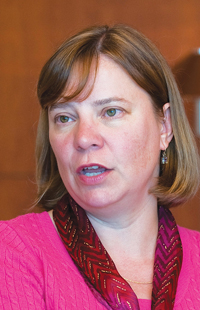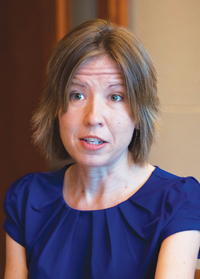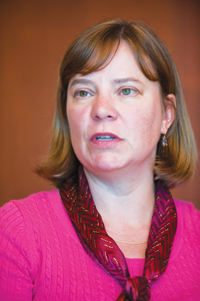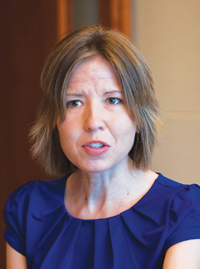fedgazette: Your recent research focused on the economic effects of enterprise zones, particularly on Minnesota’s JOBZ program. What initially interested you in looking into that program?
Laura Kalambokidis: My field is tax policy, but I also work on community economics and economic development. The enterprise zone idea—location-specific business tax incentives to try to spur economic development—is sort of the intersection between them. I wanted to start working in that area, and almost as soon as I got to the University of Minnesota in 2003, this program was proposed. People in Extension asked me, “Is this a good idea?” “What’s going to happen?” “Should communities get involved in this program?” So I started to look into it and try to answer those questions.
Tonya J. Hansen: I came from South Dakota, where I grew up on a rural family farm. I witnessed the consequences of declining economic activity in rural areas. So when this topic came up while I was a Ph.D. student, it was one that was of interest to me personally. Ideally, we’d like to focus on a strategy that would be successful. Is this [program] successful? If not, what other types of economic development would provide opportunities to rural areas?
fedgazette: Could you explain what JOBZ is, and how it is supposed to work?

Laura Kalambokidis
Kalambokidis: Well, it’s in the class of location-specific business tax incentives like enterprise zones, where the idea is to reduce business taxes in a targeted location. So businesses move there because they’re going to have reduced costs, and they’re going to invest, and they’re going to hire people, and you’re going to get more economic activity in the area.
A couple of things make it different. It’s longer term than many programs. It’s 12 years worth of tax incentives or tax breaks. The tax incentive also is available in pretty much all of greater Minnesota. Even though the specific parcels where the incentive was supposed to be allowed were all chosen carefully, the law allowed for swapping of zone acreage, as long as there was no net increase in acreage. So, in effect, it meant that the tax incentive was available almost everywhere except the metro area.
Hansen: Another primary difference with JOBZ is the type of benefits available. A lot of state programs focus on either capital subsidization or labor subsidization. With JOBZ, provisions relate to both capital-intensive and labor-intensive businesses. Thus, firms of different types are able to receive a variety of subsidies.
Kalambokidis: There also is a jobs credit associated with this program, but what it really is, is a tax-free zone. When you enter into one of these business subsidy agreements with a locality, and the state approves it, then you get exemption from a number of state and local taxes for a number of years. So it’s not like you invest $100,000 and you get 3 percent of that back. It’s that the locality has agreed that $100,000 worth of capital investment plus 85 jobs means you’re qualified and you’re going to get exemption from the corporate income tax, property tax and so on.
fedgazette: How well did the program work, in terms of job growth?
Kalambokidis: Well, let me be clear on what we did. What you probably would like to know is a different thing [laughs]. We did not have access to data that would have allowed us to find out how many jobs were created as a result of the program. We did have access to these business subsidy agreements and the reports by businesses on how many people were hired, what the wages were, that kind of thing.
So we started with these business-reported numbers of how many people they claimed they hired as a result of the JOBZ program. Then we wanted to find out whether those JOBZ-related jobs had an impact on important economic development variables at the county level.

Tonya J. Hansen
Hansen: Changes in employment, changes in population, changes in income per capita—those were, in a sense, our economic growth variables. In addition to looking at capital investment and job creation as independent variables, we also included a host of other variables that were of a demographic nature, or infrastructure nature, to characterize the climate for business in that area.
fedgazette: I also noticed that among your control variables was whether there was a highway going through the town, for example. So could you tease out how important they were relative to some other things like, say, education?
Kalambokidis: In this literature, you want to control for the other things that could have made a place attractive to a business. For some businesses, it was a highly educated workforce; for some businesses, it’s transportation infrastructure, things like that.
fedgazette: What did you find in your analysis?
Hansen: Our initial analysis was at the county level. In terms of the first three years of activity, we found little impact of the JOBZ program on county-level economic growth—very few of the JOBZ-related variables were statistically significant. The exception was a positive association between JOBZ-related employment and population growth, but that impact was economically small.
So that led the two of us to think maybe that the county lens was so large that JOBZ-related activity didn’t appear to be significant, [and] we should look at a smaller [city or census tract] level to consider whether JOBZ-related variables are significant.
Kalambokidis: It would be consistent with what we found if the JOBZ-related jobs and investment didn’t influence those economic growth variables. But it also could have been the case that JOBZ did influence one of those variables in a positive way, but something else in the county brought it down, so that on net it got washed out. We don’t know whether that happened, but the next level of analysis is to rule that out—or in.
The approach is to give the data and the program every opportunity possible to show us what happened. So we have to tease down to another level and try other things. But our analysis didn’t show on net that these tax-incentive-related jobs significantly influenced the county economic growth variables.
fedgazette: Is that fairly consistent with what has been found about enterprise zone programs in other states or municipalities?
Kalambokidis: If you look at the big body of work on enterprise zones, the evidence is really mixed. Some studies find an impact, some studies find a small impact, some studies find no impact under certain circumstances, some find it’s positive for a while, negative later. It’s all over the map, but you can’t really point to a consensus that these things have a positive impact. And the results of the studies depend a great deal on and vary by the type of program, the location, the type of incentives, the data available to the researcher, the methodology used.
Hansen: There are also a lot of mixed results within individual programs. For instance, one program at the state level would show positive effects or negative effects, but at the local level (within particular cities or counties) would show just the opposite effect. It is common to see different effects across space or size and also across time.
Kalambokidis: So in a general sense, this program and our study are consistent with what others have found. I think if we had found some dramatic positive effect, this study would look like an outlier to that literature.
fedgazette: Upon first examination of this program, one might think that if a business was offered tax cuts to hire people, then it would probably hire some people. Could you explain why those effects might not be so apparent?
Kalambokidis: Well, suppose you’ve got a business, and in one year it’s got 100 employees. And you look at it the next year, and it’s got 200 employees. In the meantime, it got a tax benefit. Say the tax benefit was tied to the number of employees that got hired, so maybe it lowered the cost per worker enough that they hired more workers. Or it could be that their production model was to hire those 100 workers no matter what, and, son of a gun, they got a tax benefit as well. And so just by looking at the before and after, you don’t know if the additional hiring is a consequence of the tax benefit or not.

Now, this “but for” question—What would have happened but for the incentive?—is the holy grail of research on economic development and location-specific business tax incentives. And the reason it’s so hard is because you need a group of communities that didn’t get the tax incentive, but are just enough like the communities that got the tax incentive that you can’t argue that there’s some systematic difference that caused a difference in outcomes. Then if you’ve got that control group, you can tease out statistically the impact of the tax incentive.
The problem is trying to find that control group. Because in any state, you have a hard time finding a group of communities that’s just like the ones that got treated. With enterprise zones, it’s because the zone communities are very specific geographic places and your control communities are something completely different. But even if you have a bunch of communities that you could use as a control group, you don’t necessarily have the level of data on them that you do on the treatment group. The businesses and communities that got the tax incentive had to go through some sort of an application process. In this case, businesses go through an application process, and we gathered the data on them, but we don’t have the data on businesses that are just like those businesses but didn’t get the tax incentive.
Hansen: From a researcher’s perspective, the ideal situation would have been that businesses in greater Minnesota would have all applied and filled out business subsidy agreements, but not have known at the time they completed them whether they were going to be in JOBZ or not. If some were chosen and others were not, that would be a much easier study.
Kalambokidis: [Laughs] It wouldn’t have been great policy necessarily!
fedgazette: Is the way you set up your analysis by looking at other climate variables a way of compensating for the problem that you just don’t have a counterexample?
Kalambokidis: I wouldn’t say compensating. It’s a preliminary step. We’re still looking at the possibility of finding a “control group” and firms that we could follow over time. But no, our study is really looking at correlation, not necessarily causation, although we’re controlling for as many things as we can. We’re not really getting to the “but for” question.

Hansen: You have to work with the data that you have access to. It’s still an interesting question in Minnesota regardless of whether the data were messy or whether they were easy to acquire. And it’s still important to the taxpayers of Minnesota to know whether this program was a good investment or not.
fedgazette: If it’s hard to point to big successes from these programs, why are they so popular?
Hansen: I would say the general reason they are popular is that communities fear being left behind if a neighboring community (which is perceived as competition), is offering the program. Communities will offer a similar set of incentives, irrespective of whether they have shown success.
A locality’s view that the strongest competition for employment opportunities is its neighboring county or state is biasing the construction of economic development programs, in my opinion. Investments that strengthen the ability of a location and its workforce to be productive may offer more opportunities for long-term economic growth than simply adding an incentive that your neighbor has.
I can match incentive by incentive for nearly all of the 50 states. Has any state gained any leverage in the process? Probably not.
Kalambokidis: One of the reasons they’re popular is that local community development professionals want to have tools and subsidies and incentives available to them when they have that negotiation with a business to try to bring it in or have it expand. In this case, it was mostly state revenue that was being given up. If the states can offer the locality the opportunity to offer a business exemption from state taxes, the locality’s going to be happy to have that tool. … There’s not a lot of downside. [In some cases they might] potentially forgo local property taxes. But anecdotally, a lot of these parcels that were named as subzones were undeveloped parcels. And so they weren’t generating property tax revenue anyway.
Hansen: From the cost-benefit perspective, the costs were next to nothing for some local communities. For the benefits, anything greater than nothing was considered a success from their viewpoint.
fedgazette: What were the factors you found that were connected with economic growth measures?
Hansen: Education, age of the population and preexisting unemployment conditions in the county.
Kalambokidis: So it argues for the quality of the workforce or some character- istics of the workforce being significant for county-level economic growth over that period. Those are the ones that turned out to be significant. We thought some of the others might be important, like infrastructure and so on. But we both thought it was noteworthy that it was labor that mattered here more than some other things.
fedgazette: What, if anything, does that imply about the types of economic development policies that might be effective?
Kalambokidis: If there were some sort of magic formula, we’d be done with our work here [laughs]. But what I can say is that the role of the state really should be to provide those services and make those investments that make the state a place where people really want to live and work, and businesses can easily start up and thrive.
And so you’re talking about workforce variables, education all the way from early childhood to lifetime education and workforce retraining. You’re talking about physical infrastructure and transportation and technology. You’re talking about higher education. You’re talking about natural resource management, cultural amenities and arts amenities. These are all things that the state invests in and that help a business start up and be able to attract employees and be a place that can thrive.
fedgazette: Thank you.
Joe Mahon is a Minneapolis Fed regional outreach director. Joe’s primary responsibilities involve tracking several sectors of the Ninth District economy, including agriculture, manufacturing, energy, and mining.




